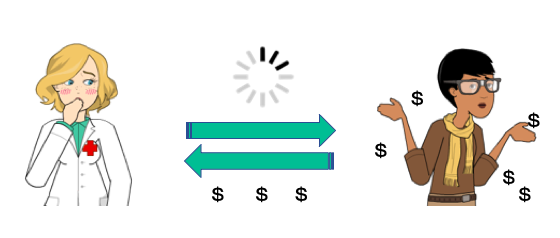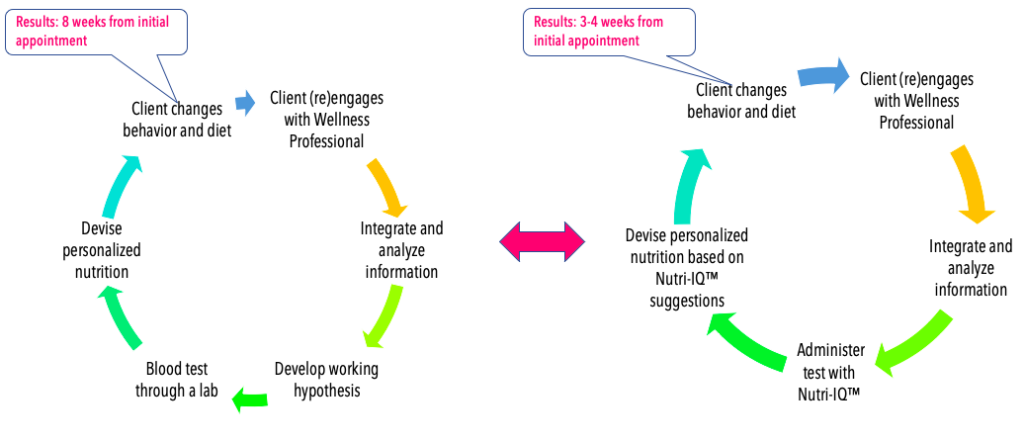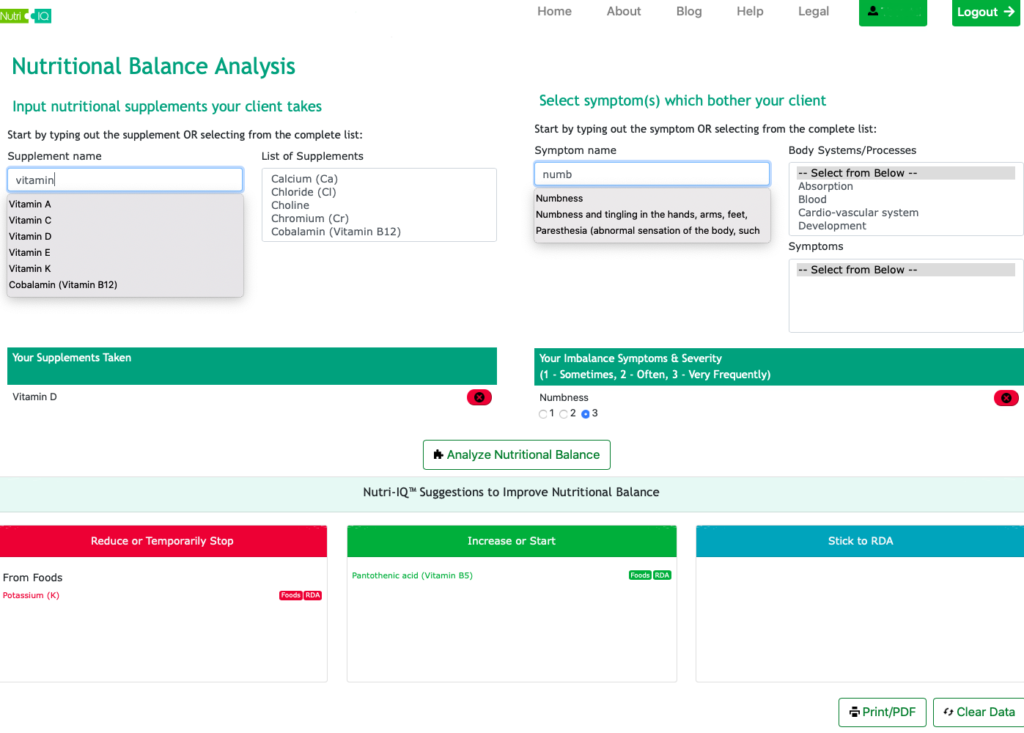Nutri-IQ Virtual Testing to Improve Wellness Practice Profitability
On this page
Nutri-IQ™ is a holistic tool that interprets body signs as nutritional and other imbalances. Use Nutri-IQ testing to improve wellness practice profitability and bring a client to health in reliable and efficient way.
Abstract
In this article, we present Nutri-IQ protocol. It helps to achieve and improve wellness practice profitability while following emerging wellness industry trends:
1. Personalized nutrition: an actively developing business niche of wellness industry1. Many wellness practices embraced at least some nutrition personalization.
2. Moving wellness practices online as a response to COVID-19 situation. Now, practitioners can see a client, talk to her, provide recommendations, and monitor her progress from their electronic devices. Online presence requires good set of effective and efficient online testing tools.
We also present ways how to improve customer satisfaction and profitability of the wellness practice.
Introduction
Personalized nutrition is an actively developing business wellness industry niche. To succeed and make money in this niche , we need to understand client’s nutritional status as one of the likely causes for the complaints.
- The wellness practitioner can have an easy win (better results, stellar reviews, and higher revenue) with nutritional intervention, if nutritional gaps are known.
The nutritional gaps are routinely identified with nutritional blood panel tests sent out by test providers and administered either by a wellness professional, or at a specimen collection site. However, the planet is adjusting to COVID-19 reality. On-site administering of any tests represent a major inconvenience for the clients that try to avoid hospital and lab settings for the fear of COVID-19. And unfortunately, blood collection sites (i.e. hospitals) also have different priorities now. Thus, in today’s challenging environment many practitioners rely mostly on their guesswork to figure out potential nutritional deficiencies.
What if we had a non-invasive nutrient test that can be performed remotely? The ideal solution would enable monitoring the client’s progress remotely, seamlessly, and conveniently for the client. The protocol embracing this idea is presented in this article. It is based on Nutri-IQ Nutritional Balance Testing tool. We will show how using our protocol in your practice will lead to up to increase of your revenue, even if your customer base stays the same (we actually hint that it will grow).
Working with Wellness Practice Client
We, wellness professionals, mostly deal with subclinical manifestations when our clients look for solutions her problems but cannot find any. Successful reinstatement of nutritional balance (homeostasis) via relevant testing may be a relatively easy but very effective approach that will allow your wellness practice to stand out from the competition.
Working with a Wellness Practice client while monitoring her progress, can be conceptualized as a cyclical process of consultations and testing2. In our case, the process will be repeated until the majority of client’s complaints are addressed via nutrition and/or lifestyle changes.
There may be some insurance coverage for the requested services. Most insurance plans would limit nutritionist coverage for up to 3 hours/annually. Blood nutrient test panel would mostly be covered once a year for minority of the plan subscribers who may qualify (i.e. kidney or diabetic patients).
Financial Aspects of the Common Protocol
Let’s assume the client subscribed for a package consisting of a set of 5 sessions. During this program, the intervention will be recommended, adjusted as needed, and results checked afterwards to confirm the progress. That means the client meets with Wellness practitioner 5 times and undergoes at least 2 tests. The average cost of 5 hours program is about $600, or $120 per hour.
- Practitioner’s revenue: packaged program cost + 2x test administration fee (assuming $30) = $660
- Client pay & insurance reimbursement:
- Insurance coverage: 3 hours ($360)
- Client out of pocket expense is $1100:
- 2 hours ($240)
- 2 tests, $430 with administration
If the test quality was sufficient, some positive results may be seen as early as by 3-rd appointment, 2-3 months from initial meeting. At least 8 weeks lead time includes test shipping and waiting for results (i.e. Organic Acid Test results are provided 33 days after test submission). This is money very well spent! Annually, the client who trusts you may buy 2 or 3 programs addressing different aspects of her wellbeing, for duration of about 6 month. Of course, as long as she or her insurance are willing to pay.
Practicing in Virtualized World
Problems of the Common Protocol
Practice protocol haș problems if, as a result of its application, the clients do not come back for that personalized nutrition, or practice has less than stellar reviews. In other words, despite the best efforts, the practice does not bring sufficient income.

There may be different scenarios which result in lost clients:
- The part of a Virtual Wellness Practice that is not virtual (specimen collection) and represents great risk and inconvenience for the clients
- Results are not coming fast enough
- Despite of expectations, client’s condition does not improve or even deteriorates
- The client out-of-pocket expenses are not affordable
These factors of reduced customer satisfaction represent risk for your income, but also a potential for your business transformation! Addressing these problems with Nutri-IQ will improve customer satisfaction and positively affect practice’s bottom line. Let’s explain how.
Solution: Nutri-IQ In-House Testing and Revenue Increase
Yes, it is possible to get to the point where wellness practice’s revenue will GROW, the client will pay LESS, and leave stellar reviews! Our team did come up with the protocol that addresses major issues of today’s customer satisfaction. When you use Nutri-IQ testing, major problems affecting customer satisfaction are addressed:
- No in-person blood collection required.
- Noticeable positive changes may start right after the very first visit reducing twice time before.
- Out-of pocket client’s expenses for the same program are reduced up to 70% (we will provide more detailed explanations below).
Nutri-IQ tests are performed virtually and can be repeated as many times as needed, for no additional practitioner’s expense. The tests are functional, i.e. they interpret what the client systemically feels from the standpoint of nutrient imbalances, deficiencies and toxicities.
There is no magic around it (well, a little bit of Artificial Intelligence does not count, does it?) The major data sources are the very respectable: US National Institutes of Health and US National Academy of Medicine (NAM). Believe it or not, nutritional blood panels can produce contradictory results. Reliability of Nutri-IQ test results will solely depend on sincerity of the client. Hence, the more accurate the client would answer questions about her symptoms, the better results the test produces.
So, let’s assume the client purchased 5-sessions program, for the same $600. We recommend that nutritional testing is administered 4 times, to confirm the progress and adjust recommendations.
Let’s review financial outcomes of this protocol for full course of the program:
- Practitioner’s revenue: packaged program cost + 4 x test administration fee (same $30) = $720, that is 9% higher than without Nutri-IQ.
- Client pay & insurance reimbursement:
- Insurance covers: 3 hours ($360)
- Client out of pocket expense is $360 to cover:
- 2 hours ($240)
- 4 test administration fees ($120)
We assume here that only Nutritional Balance test will be administered. In fact, other Nutri-IQ tests also can be administered and charged accordingly with no additional cost to the practice, thus improving outcomes and increasing revenue:
- Nutritional balance
- Histamine intolerance
- Toxin exposure
- Risk of getting sick during COVID-19 pandemic
- Cardiovascular disease risk
Comparing Nutri-IQ Protocol vs Traditional Protocol
We can see immediately that application of Nutri-IQ protocol leads to:
- 9% increase of the practice revenue
- Improved Customer Satisfaction via:
- 67% reduction of client’s out-of-pocket pay compared with a protocol using blood sample testing ($1100)
- meeting expectations regarding prompt positive outcomes of the treatment: obtaining reliable results in at least 3-4 weeks after initial engagement, vs 8 weeks
- exceptional convenience of the virtual testing in the comfort of client’s own home
Let us re-iterate. Your revenue grew (hurray!), client’s per-program out-of pocket expenses reduced, and clients reliably had seen positive results after the very first appointment, twice as fast compared to current protocols. This is what they will brag about on social media!

How to Use Nutri-IQ Testing
Nutri-IQ™ is your in-house lab you use to personalize nutrition for your clients. Our method does not need to draw blood or any other bodily liquid. It allows to assess virtually:
- The state of 29 essential macro- and micro-nutrients functionally, by the nutrient action on the body
- Probability of histamine intolerance
- Probability of 25+ toxin exposure
- Risk of getting sick during COVID-19 pandemic
- Cardiovascular disease risk
The assessment is qualitative. For example, it determines if a nutrient in question is balanced, or there may be suspected imbalance (excess or deficiency), or interaction with some other nutrients. Assessment is performed based on the data which the client had identified during the discovery discussion. The tool is using supplements and symptoms as inputs.
Please note that your subscription does not limit number of clients assessements! For an average practice that runs 100 annual personal 5-hour programs, the cost is about $1/program/year (yes, we give discounts, lot’s of them!)
All you need to do is to follow 5 simple steps:
- Identify symptoms bothering your client (either directly or by body system)
- Input supplements your client takes (if required by the test)
- Click the button to perform assessment with Nutri-IQ
- Use analysis results and our Blog to fine-tune client’s diet and supplementation
- Print out client hand-out and save Nutri-IQ suggestions for further use
Presented in Appendix Case Studies show how to apply these steps in real-life examples.
Conclusion
We hope you are convinced now that non-invasive test of nutritional balance can it be performed remotely. If you are just starting new practice, moving exiting practice online, or want to be more successful practitioner, Nutri-IQ Virtual Lab will be an invaluable in-house lab for you! Using Nutri-IQ-based protocol in your practice will lead to up to 9% increase of your revenue compared to existing practices, and will bring resolution to many existing and new clients. Don’t wait, register with us!
Appendix
(Un)Reliability of Nutritional Blood Panels
We usually consider nutrient blood panels as reliable. Wellness professionals rely upon several testing methods that can be used to provide knowledge of the current state of the nutrients in the client’s body. These tests allow us to see direction to go, from the first meeting with the client. We cannot afford our success rate to be low! As we try our best to help the client, the guesswork may be detrimental to our bottom line. We want to get results!
But how reliable they are? Let’s look at some publications which came up with astonishing results.
According to the US National Institutes of Health, vitamin A levels in plasma do not decline until vitamin A levels in the liver are almost depleted3. Evidence suggests that serum vitamin B12 concentrations might not accurately reflect intracellular concentrations4. Serum folate concentrations are sensitive to recent dietary intake5, so it might not reflect long-term status.
There is a review devoted solely to vitamin D testing 6. The same specimen was tested in 1,090 different laboratories around the world. All labs applied sufficient quality assurance methods. Different assessment methods were utilized. Most commercial pathology laboratories used an automated immunoassay, such as Diasorin liaison, to measure the 25(OH)D concentration. More specialized laboratories used a liquid chromatography tandem mass spectrometry (lc-Ms/Ms) assay, which provides superior performance. The results were striking: there was 5 times difference in readings, and the level of 25-hydroxyvitamin D (25(OH)D) was reported from insufficient to toxic!
Nutri-IQ Protocol Application: Case Studies
Nutritional problems are multifaceted. In the article about nutritional balance 7, we already mentioned that with nutrients imbalance, the living organism enters a chain of problems that may eventually become a disease, clearly pronounced, or with sub-clinical symptoms. Despite of the fact that nutritional homeostasis is often neglected by mainstream medicine, it contributes to degenerative processes such as arthritis, cancer, cardiovascular disease and diabetes.
Nutrient imbalances can mask themselves as diseases8. Nutritional problems also can be related to the medications your client takes 9.
We all like recommending supplements. Dietary changes may be life-saving! However, before recommending any supplements or specific “therapeutic” foods though, we need to understand if this is a feasible option. The rule of thumb is that supplement is recommended if:
- the diet is missing a specific nutrient (i.e. testing is to be conducted),
- the body cannot absorb the nutrient from foods and supplements,
- there are therapeutical or overall health reasons 10.
Let’s consider several Case Studies. As you see, all hypotheses can to be verified with nutrient testing!
CASE STUDY #1
The client was diagnosed with Bradycardia (very slow heart rhythm) about 5 years ago. Multiple medical tests were normal, and reason for bradycardia was not identified. As a prevention measure, his doctor recommended him to avoid eating foods high in potassium (i.e. bananas). Though Bradycardia itself did not affect client’s wellbeing much and he had a good exercise tolerance, his major concern was the numbness in extremities. His doctor also recommended to take vitamin D. He visits massage and physiotherapists often. Application of those measures brought no changes to his major concern though.
The input of data into Nutri-IQ™ tool took less than a minute (are you not happy to get paid $30/minute?) When you start typing, the system provides convenient prompts so you can see what’s available in your category. Alternatively, you could choose a body system/process and pick all relevant symptoms. You also can specify the frequency of experiencing a symptom. When finished, just click on Analyze Nutritional Balance button to see results.

Nutri-IQ Artificial Intelligence engine INSTANTLY identified surprising nutrient, vitamin B5, deficient in the client’s body, suggesting easy fixes to client’s diet and supplementation.
It was observed that bradycardia sometimes is accompanied by numbness, especially when toxins enter the body 11. Though the tool did not get any inputs about potassium or bradycardia, doctor’s hypothesis of potassium toxicity was confirmed just based on client’s nutritional profile!
The recommendations can be archived for the practitioner and given to the client as a reminder.
Below is the hand-out, a tasty prescription that was provided to the client. Please note that the print-out does not contain any privacy-sensitive information about the client. This information will be used for personalization of nutrition plan for the client. Following vitamin B5 supplementation, the client was able to adjust his diet and address numbness. The numbness was gone in 4 weeks!

CASE STUDY #2
An elderly client (80 yo), female, generally healthy and physically active, with a good diet, has a slew of complaints. She does not eat red meat, but consumes lots of eggs, cooked and canned fish. She takes low-dose vitamin C before bed and vitamin D. She was diagnosed with hypothyroidism and takes a very low dose of levothyroxine. Her goal is to feel better and get rid of leg pain, and nocturia if possible.
In this case, discovery session took about 30 minutes. The following symptoms were revealed:
- Hypertension, Petechiae, Frequent urination, Goiter, Hypothyroidism, Arthralgia, Joint effusions, Bone pain, Cramps (muscle), Muscle aches, Muscle weakness, Disorientation, Neuropathy, Dry, watery, or itchy eyes; Edema, Alopecia (hair loss), Dermatitis (Seborrheic), Pruritus, Skin lesions, Sweating
Do you have any idea about what’s going on? You probably guessed about vitamin B deficiency and vitamin C timing. Let’s see what our Nutri-IQ tool found:
- The tool provided recommendation to reduce consumption of the foods containing vitamin B1, choline (eggs!), sodium, selenium.
- The tool also advised to supplement and/or increase consumption of good foods containing: vitamins B5 & B12, biotin, calcium, phosphorus, potassium, zinc, essential fatty acids, iodine, and manganese.
We suggested that the client moves vitamin C intake to the morning and commences supplementing with vitamin B-complex and liquid calcium with manganese. The muscle pain and nocturia were gone in 2 weeks! During the follow-up appointments, we were talking about reduction of inflammation, her immunity and help with hypothyroidism.
In conclusion of the Case Studies discussion, we recommend to keep testing results handy, in a dashboard, so you can have the progress and recommendations obtained from Nutri-IQ handy. We would be honoured if you use our template.
References
- Rankin A, Kuznesof S, Frewer LJ, et al. Public perceptions of personalised nutrition through the lens of Social Cognitive Theory. J Health Psychol. 2017;22(10):1233-1242. doi:10.1177/1359105315624750
- Committee on Diagnostic Error in Health Care; Board on Health Care Services; Institute of Medicine; The National Academies of Sciences, Engineering, and Medicine; Balogh EP, Miller BT, Ball JR, editors. Improving Diagnosis in Health Care. Washington (DC): National Academies Press (US); 2015 Dec 29. 2, The Diagnostic Process. Available from: https://www.ncbi.nlm.nih.gov/books/NBK338593/
- Vitamin A: Fact Sheet for Health Professionals https://ods.od.nih.gov/factsheets/VitaminA-HealthProfessional/#h3
- Vitamin B12: Fact Sheet for Health Professionals https://ods.od.nih.gov/factsheets/VitaminB12-HealthProfessional/
- Folate: Fact Sheet for Health Professionals https://ods.od.nih.gov/factsheets/Folate-HealthProfessional/
- Robyn Lucas, Rachel Neale, What is the optimal level of vitamin D? Separating the evidence from the rhetoric, Australian Family Physician, vol.43, No.3, March 2014
- Importance of Nutritional Balance for Human Life https://www.nutriiq.ca/wordpress/importance-of-nutritional-balance/
- Nutritional Imbalances Masking As a Disease https://www.nutriiq.ca/wordpress/nutritional-imbalances-masking-as-a-disease/
- Essential Nutrient Interactions with Medications https://www.nutriiq.ca/wordpress/essential-nutrient-interactions-with-medications/
- Annette Dickinson, Nicolas Boyon, Andrew Shao, Physicians and nurses use and recommend dietary supplements: report of a survey, Nutrition Journal volume 8, Article number: 29 (2009)
- Tai-Yuan Chen, Cheng-Hong Hsieh, Deng-Fwu Hwang, Development of standardized methodology for identifying toxins in clinical samples and fish species associated with tetrodotoxin-borne poisoning incidents, Journal of Food and Drug Analysis, Volume 24, Issue 1, 2016, Pages 9-14, ISSN 1021-9498,https://doi.org/10.1016/j.jfda.2015.05.004.
